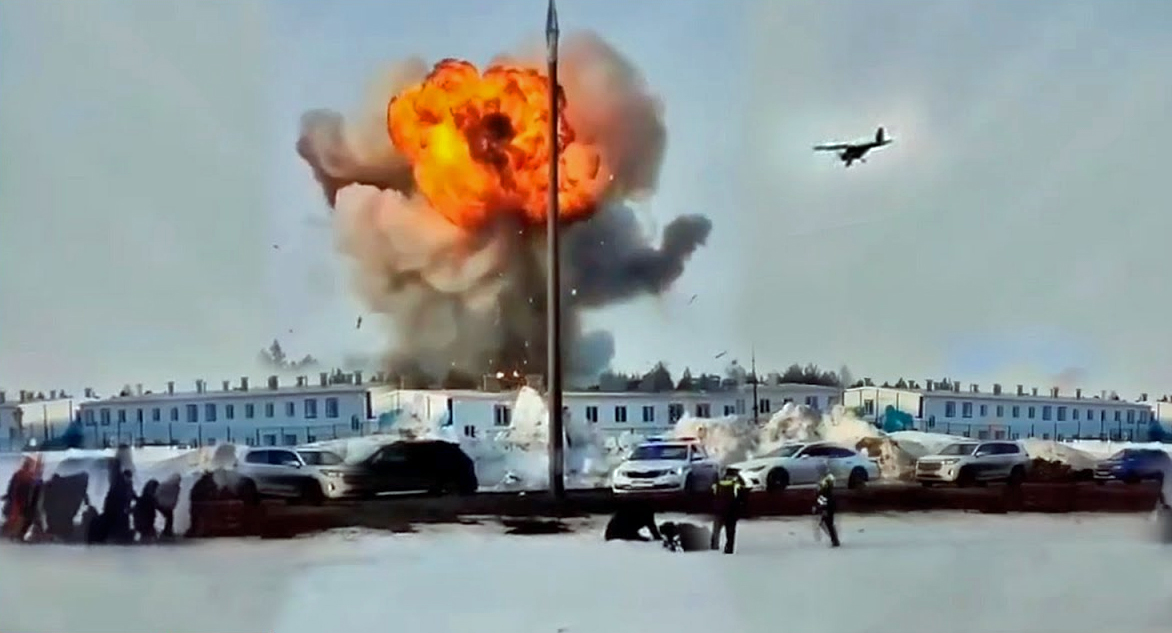The Crimean Bridge, also known as the Kerch Bridge, has strategic value as a symbol of Russia’s “possession” of occupied Crimea and tactical value as a logistical link from the mainland.
The bridge has already been struck by Ukraine twice and partially repaired – there is some doubt as to its continued structural integrity to move tanks and supplies. In October 2022 a bomb carried in a truck damaged several spans of roadway and the adjacent rail line. In July last year an early morning USV strike caused further damage to the road section.
JOIN US ON TELEGRAM
Follow our coverage of the war on the @Kyivpost_official.
In April a spokesperson for Ukraine’s Main Intelligence Directorate (HUR) said a third attack on the Kerch bridge between Russia and occupied Crimea was “inevitable.” Russia has taken Kyiv’s threat seriously.
According to UK intelligence assessments, it had already begun constructing barriers consisting of floating and sunken barges, anti-submarine / USV nets, naval mines, barrels linked with cables, and smoke generators to mask the view of the bridge alongside increased numbers of air defense systems in the fall of 2023.
In early August satellite images showed what appeared to be preparations to build a permanent structure alongside and parallel to the bridge. By the middle of August, the construction was reported to be progressing well. Speculation has grown as to its purpose.
It could be an additional single-lane bridge or possibly a more durable barrier to protect against the large explosive warheads carried by Ukraine’s MAGURA V5 and Sea Baby kamikaze unmanned surface vessels (USV). The improvised protective barriers so far in place are vulnerable to storms and high seas, having been broken up several times, with debris such as plastic barrels scattered and washed up on the Kerch embankment and shoreline.

North Korean Troops Face Major Losses in Kursk: The Cost of Russia’s Desperation

Today images appeared of new large metal anti-USV “ruffs” being taken on barges before being sunk close to the bridge as yet further protection.

On Wednesday last week, further evidence of Moscow’s desire to keep the bridge intact along with the expectancy of further Ukrainian attacks was the deployment of an unusual version of the Pantsir (NATO: SA-22 Greyhound) self-propelled, medium-range combined surface-to-air missile and anti-aircraft gun systems.
Images published by the “Crimean Wind” Telegram channel show the placement of what appears to be the export version of the Pantsir-S1M directly on the Crimean Bridge. Review of Satellite images of the area suggests that it has been deployed on and around the bridge for at least a month.
The system consists of three vehicles: a missile launcher, a radar truck and a command post. The variant seen on the bridge has an armored cabin mounted on a KamAZ-53958 chassis and is painted in desert camouflage. This particular variant has only previously been seen on this year’s Victory Parade in Tula and exhibited at the “Army-24” forum although similar versions have been seen deployed overseas.
It is said to incorporate several tactical and technical upgrades including enhanced range and altitude using two types of missiles: the standard 57E6-E and the improved 57E6M-E which has a larger 25 kg warhead, an increased ceiling from 15 to 18 km (9.3 to 11.2 miles), engagement ranges from 20 to 30 km (12 to 19 mi) and a speed of 4,700 to 6,100 kph (2,900 to 3,800 mph).
The Pantsir-S1M is intended for close-in air defense of key units, military and civilian facilities, and missile sites. Although the export version is designated S1-M it is actually a version of the latest Pantsir Series 2 which is slowly being introduced into service.

The desert camouflage on the equipment deployed to the bridge suggests it may have been diverted from an external customer or been redeployed from Syria, where the S1-M / S2 was seen previously.
The Atesh partisan group said that Russia had begun redeploying air defenses to shield the Crimean Bridge at the end of July.
“The Armed Forces of the Russian Federation began to massively transfer equipment closer to the Kerch Bridge,” the group said in a post on its Telegram channel on July 25.
They said that Russia was “actively redeploying the surviving air defense installations, aircraft, radars and all military facilities from the western part of Crimea.”
A spokesperson for the Ukrainian Navy, Dmitry Pletenchuk, was dismissive of the ability of the Pantsir-S1M air defense system to protect the Kerch Bridge.
“I remember the missile ship Cyclone [which was sunk in May in Sevastopol Bay] … it had the naval version of the Pantsir-S on board. That's all you need to know about the ability to repel serious attacks – this complex could not defend itself,” the speaker said on the air of the Ukrainian national telethon.
“… we must take into account everything the enemy knows, everything he puts forward. And he puts forward everything he has. That's the paradox... They are making every effort to preserve the bridge,” Pletenchuk added.
You can also highlight the text and press Ctrl + Enter






